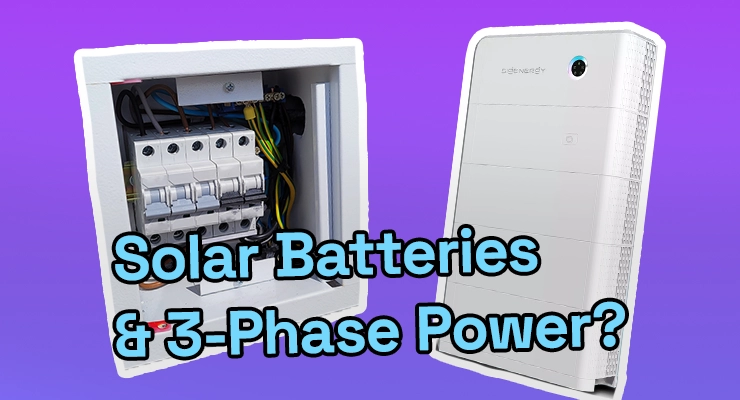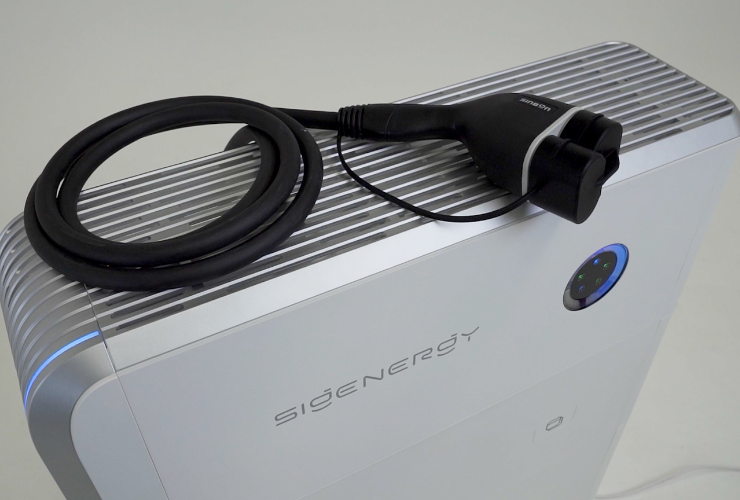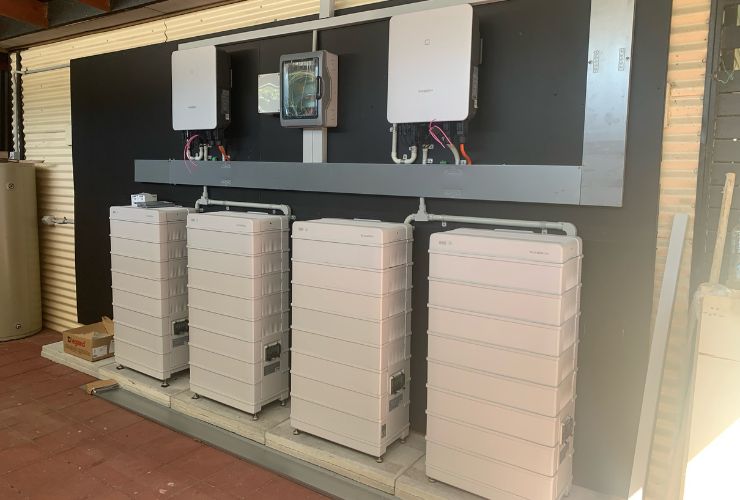Fast read
Yes, you can use solar batteries to stabilise and enhance a home with three-phase power, a common solution for larger Australian homes. The key is using a specialised three-phase hybrid inverter to manage and balance the electrical load across all phases. This setup provides comprehensive backup power, improves efficiency, and maximises solar self-consumption.
Can I use solar batteries to stabilise a home with three-phase power?
For homeowners with three-phase power, the question of integrating solar and battery storage can seem complex. Often found in larger residences, rural properties, or homes with powerful appliances like ducted air conditioning, electric vehicle chargers, or large workshop equipment, a three-phase supply provides a more robust and stable connection to the grid.
The great news is that modern battery systems are perfectly capable of working with, and even improving, a three-phase connection. Let’s explore how it works and what you need to consider.
How does a battery system work with three-phase power?
A standard single-phase home has one live wire delivering power, while a three-phase home has three. An electrician will typically balance the home’s circuits across these three phases to distribute the electrical load evenly.
When you add solar and a battery, the critical component is the inverter. While you can install a single-phase battery system on one of the three phases, this approach is often inefficient. It might only power the circuits on that specific phase during an outage, and won’t effectively manage your overall household consumption from your solar.
The ideal solution is a dedicated three-phase hybrid inverter. This device is the intelligent heart of the system. It converts the DC power from both your solar panels and your battery into AC power that is distributed evenly across all three phases of your home.
This ensures that stored battery energy can be sent wherever it’s needed, regardless of which phase a particular appliance is on. This process of evening out the demand is known as ‘phase balancing’, and it’s crucial for maximising the benefit of your battery.
What are the key benefits of a three-phase home?
Integrating a battery with your three-phase supply offers several powerful advantages beyond just storing solar energy:
- Whole-home backup: A correctly specified three-phase hybrid system can provide seamless backup power to your entire house during a blackout, keeping everything from the lights to high-load appliances running. This is a significant step up from single-phase systems, which often only back up essential circuits.
- Improved power stability: The system actively balances the load across the phases. This prevents one phase from being overloaded, which can cause voltage issues or nuisance tripping, leading to a more stable and reliable power supply throughout your home.
- Maximised solar self-consumption: By intelligently directing stored energy to any phase that needs it, the system ensures you use as much of your own free solar power as possible. This directly reduces your reliance on expensive grid electricity, especially during peak evening hours.
- Handling high-power appliances: Three-phase power is designed for big loads. A three-phase battery system is perfectly matched to support these, ensuring your ducted air-con, pool pump, or EV charger can run smoothly on stored solar energy.
What equipment do I need?
To achieve true three-phase stabilisation and backup, your system will require specific components designed to work together:
- A Three-Phase Hybrid Inverter: This is non-negotiable for a true three-phase solution. It manages the solar panels, the battery, and the grid connection across all three phases. Brands like Sungrow offer robust and popular three-phase hybrid inverters, such as their SH10RT and higher-capacity models, which are well-regarded in the Australian market.
- A Compatible Battery: The battery itself doesn’t need to be “three-phase,” as it stores power in DC. However, it must be compatible with your chosen three-phase hybrid inverter. Many modern battery systems are modular, allowing you to stack units to achieve the desired capacity. Sungrow’s SBR series, for example, pairs seamlessly with their hybrid inverters. Sigenergy is another brand that offers innovative, all-in-one solutions that integrate the inverter, battery, and even EV charging in a modular three-phase system.
- Smart Energy Management: The system’s software (Energy Management System or EMS) is what provides the intelligence for phase balancing, optimising self-consumption, and providing backup.
AC coupled vs DC coupled systems: Does it matter?
When adding a battery, you’ll hear the terms “AC coupled” and “DC coupled”.
- DC Coupled: In a new installation, a DC-coupled system is often preferred. The solar panels (DC) charge the battery (DC) directly, with only one conversion to AC when your home needs power. This is more efficient. Most modern three-phase hybrid inverters, like the Sungrow models, create a DC-coupled system.
- AC Coupled: If you already have a solar PV system with its own inverter, you can add a battery by “AC coupling” it. This involves a second inverter for the battery. While slightly less efficient due to extra power conversions, it’s a very flexible way to retrofit storage to an existing three-phase solar setup.
For a new installation aiming to stabilise a three-phase home, a DC-coupled system with a hybrid inverter is typically the most efficient and streamlined choice.
Questions to ask your installer
Choosing the right system for a three-phase property requires expert advice. To ensure you get a solution that meets your needs, ask your accredited installer these key questions:
- Will the system provide balanced power across all three phases?
- Can the system provide whole-home backup during a grid outage, or only for selected circuits?
- What is the inverter’s continuous output and surge capacity in backup mode? This determines what appliances you can run.
- Is the system modular, and can I add more battery capacity in the future?
- What are the full capabilities of the monitoring app and energy management software?
Your next steps
Yes, you can and should use a dedicated battery system to stabilise and get the most out of your three-phase home. By managing power across all three phases, these systems offer superior backup, improved stability, and greater savings than simpler setups. The key lies in selecting a high-quality three-phase hybrid inverter and a compatible battery.
If you’re feeling uncertain about the technical details or want to connect with accredited local professionals who specialise in three-phase installations, Your Energy Answers offers a free service to help you get clear, independent advice and quotes. Making an informed decision is the best way to secure your energy future.





